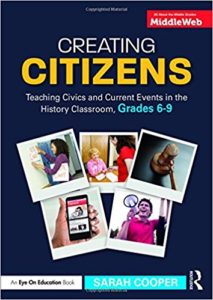Rocking the Constitution in Grade 8 History Class
A MiddleWeb Blog
 In a school year when the Constitution has exploded into the news more than ever, my eighth graders and I have carefully discussed political articles as they’ve appeared.
In a school year when the Constitution has exploded into the news more than ever, my eighth graders and I have carefully discussed political articles as they’ve appeared.
Yet I’ve also wanted to infuse life into this founding document beyond current events. Last year I spiced up a traditional Constitution unit with material from iCivics and other sources, and this year I hoped to build that curiosity factor even more.
In the process I had a lightning realization that I felt silly for not having had before. I don’t start off any other unit – ever – with a disconnected list of facts and principles. (Think: the number of terms a president can serve, the definition of the elastic clause, the powers of Congress.)
So why would I start this way with the Constitution? Something about the immensity and importance of the document had been intimidating me, but this year, I’ve vowed: No more!
Beyond Schoolhouse Rock: Invigorating the Three Branches
After we had discussed the Constitutional Convention, inspired by an Educurious unit, I asked students to draw their own flow chart of the three branches like the one shown on this official U.S. government page. To take this assignment beyond the basic, though, students had to list at the bottom of their chart any two agencies (included on the web page) for each of the three branches.
National Garden at the U.S. Botanic Garden in Fall
Together we had fun learning about the U.S. Botanic Garden (legislative), Bureau of Ocean Energy Management (executive) and Federal Court Interpreters (judicial), to name a few. This activity was so enlightening to understand the vast reach of our federal government that I would consider doing a mini-project on it in the future, to understand how national policy trickles down to the local level.
Using Actual History to Illustrate How Government Works
Ideally, English teachers avoid teaching grammar in a vacuum, outside the context of writing. So why would I as a history teacher approach the “grammar” of government out of context, asking students to memorize the number of people in the House of Representatives before they see how the House makes decisions?
This fall, inspired by the same Educurious unit, we looked at the Civil Rights Act of 1964 as a prime example of the executive, legislative and judicial branches working together.
Students started with an excellent article from CommonLit by the National Park Service on the legislation. I asked them to read the piece for homework and write “one fact/quote from the article relating to the executive branch (President), legislative branch (Congress = Senate & House) and judicial branch (Supreme Court). This will be 3 facts total.”
Then, “for each fact/quote, write a sentence explaining how the fact you cited led or contributed (directly or indirectly) to the passage of the Civil Rights Act of 1964.”
In class, we followed up with videos suggested by Educurious: two brief primary sources showing news clips from the 1960s (signing and stock footage of the act), and one secondary source from the History Channel with an overview of the act. As students watched the videos, I asked them to identify the role each branch played in the passage of this monumental act.
Of course, we only scratched this topic, especially given the arm-twisting Johnson had to do to convince members of Congress to pass it. However, I loved being able to show this bipartisan example of change in a real-world way, especially since many students already know about the civil rights movement by the time they enter my class.
Introducing a Small Gaming Factor
Although my students have loved Kahoot and its ilk for years, I’ve never been enamored of too many games in the classroom. Online learning convinced me that I needed to do something to break up hour-long synchronous classes, though, and so I’ve been using Quizlet quite a bit this year.
In previous years, I hadn’t made class Quizlets, intending that many of my students would create their own. This never seemed to happen, though, because a few generous souls in each class were glad to share their electronic flashcards with everyone (which I didn’t want to discourage).
This year, I made my own Quizlets, which were wonderful for the consistency of definitions and the ease of access to key terms. I would give students a few minutes to study in class before we did a group asteroid “gravity” game, with students unmuting and shouting out answers over Zoom. These repeated no-stakes quizzes helped make this vocabulary a regular part of class discussion, with low stress in this unusual pandemic year.
A Truly Living Document
The Constitution remains so vast that I never feel I cover it well. However, this year we tackled it in a fresh way that kept me curious, which is a great start!
Full disclosure: Educurious gave me free access as a MiddleWeb blogger to their Constitution materials, which I said I would write about if I thought they were useful. They were, and so I am! Usually, Educurious charges a licensing fee for these materials. For more information or to request a demo, please contact Blake Konrady at BKonrady@educurious.org.
Feature image source: Cecil Stoughton, White House Press Office (WHPO), Public domain, via Wikimedia Commons
 For ideas on folding current events and civics into your classes throughout the school year, try Sarah Cooper’s book, Creating Citizens: Teaching Civics and Current Events in the History Classroom, Grades 6–9, a Routledge/MiddleWeb publication. MiddleWeb readers receive a 20% discount from Routledge with the code MWEB1.
For ideas on folding current events and civics into your classes throughout the school year, try Sarah Cooper’s book, Creating Citizens: Teaching Civics and Current Events in the History Classroom, Grades 6–9, a Routledge/MiddleWeb publication. MiddleWeb readers receive a 20% discount from Routledge with the code MWEB1.

































